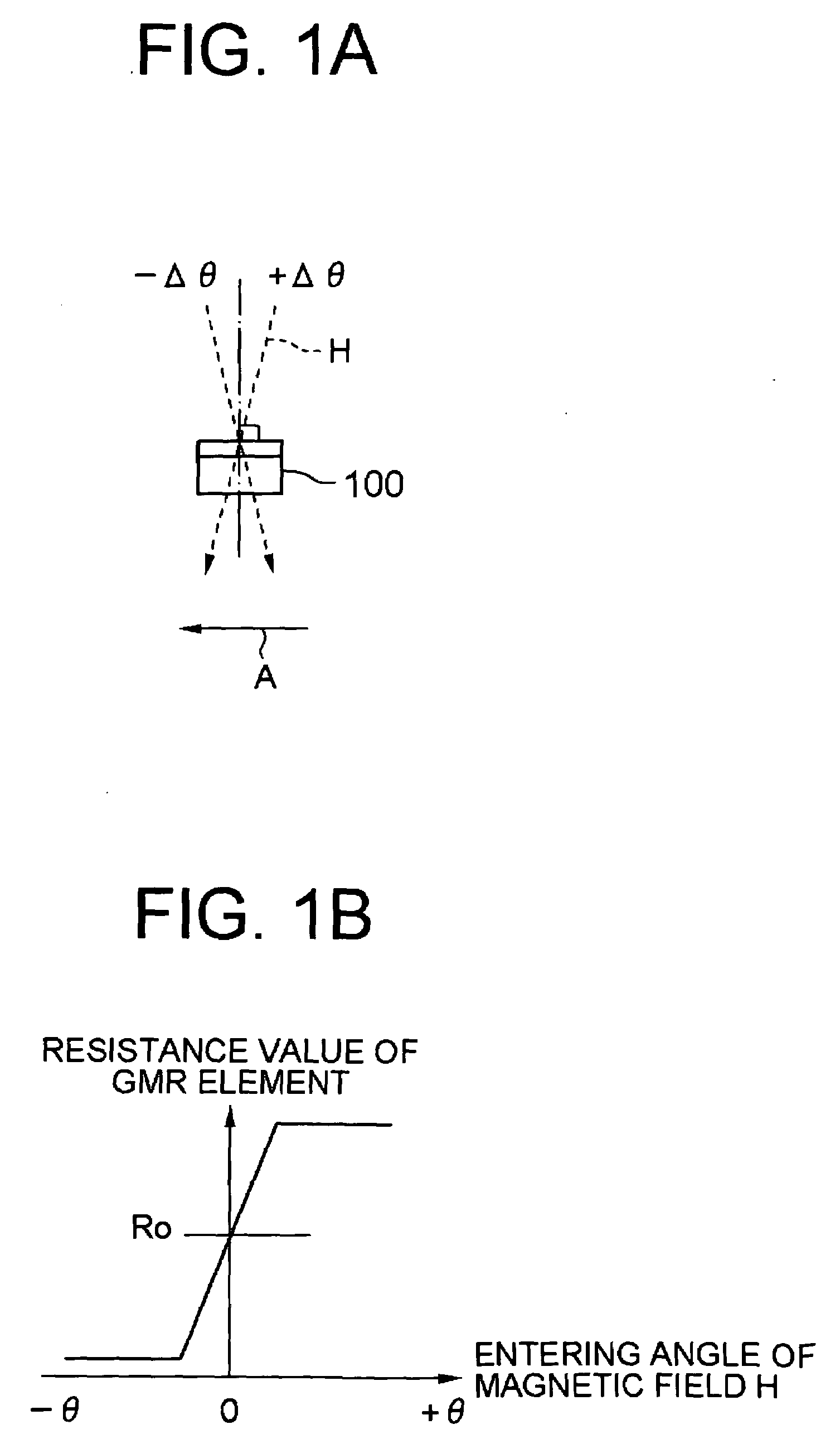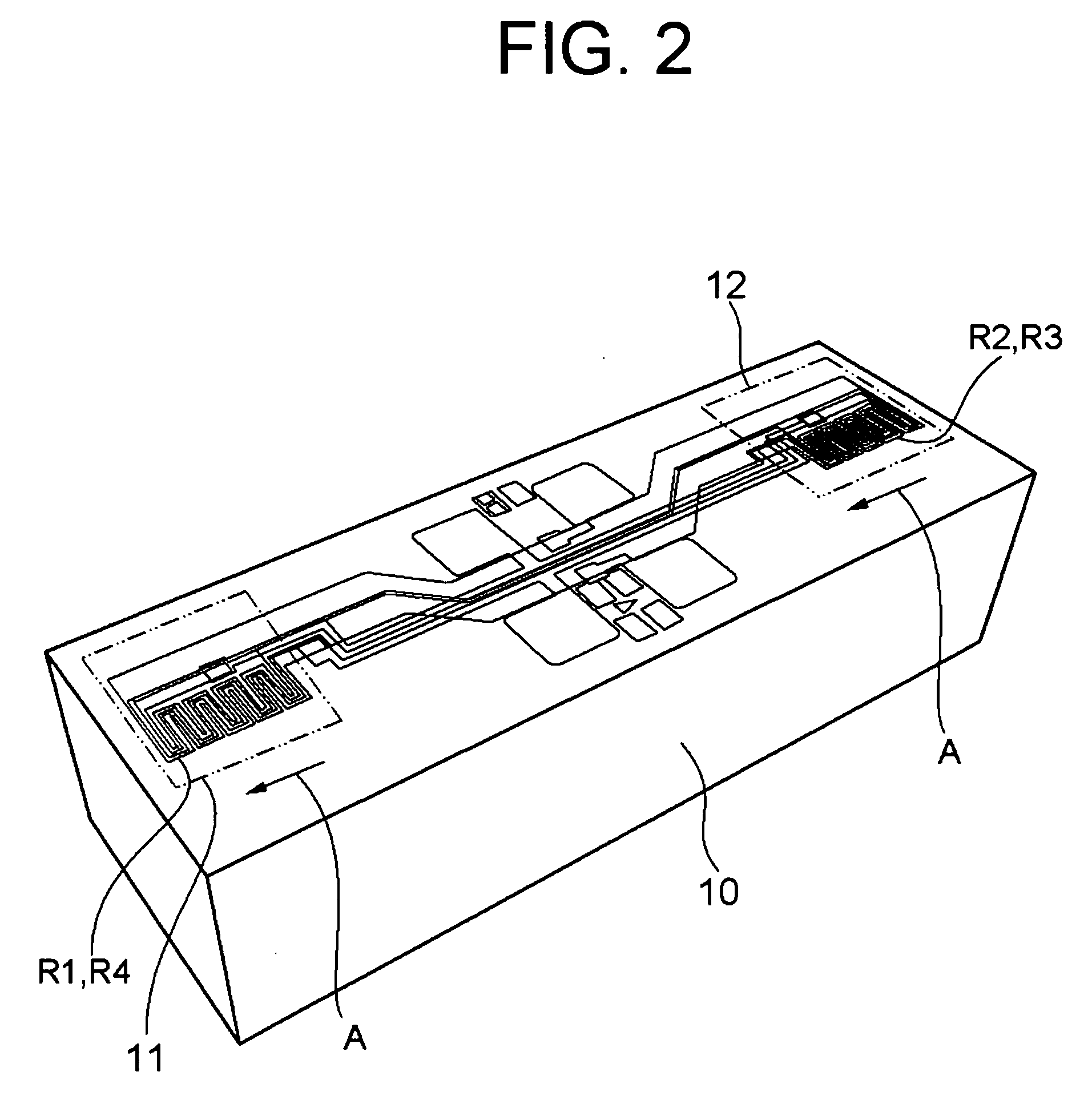Magnetic sensor
a technology of magnetic sensors and gmr elements, applied in the field of magnetic sensors, can solve the problems of inability to detect a differential voltage in the bridge circuit, inability to detect magnetic field with high accuracy, and errors in the resistance values of respective gmr elements, so as to improve the accuracy suppress variations in resistance values of respective magneto resistive effect elements, and improve the effect of detecting magnetic field
- Summary
- Abstract
- Description
- Claims
- Application Information
AI Technical Summary
Benefits of technology
Problems solved by technology
Method used
Image
Examples
first embodiment
[0043]A first embodiment of the present invention will be described with reference to FIGS. 1A to 7. FIGS. 1A and 1B are diagrams illustrating characteristics of a GMR element. FIGS. 2 to 5 show an example of a GMR chip. FIGS. 6 and 7 are diagrams showing an example of a magnetic sensor according to the present embodiment.
[0044]First, characteristics of a GMR element used in the present invention will be described with reference to FIGS. 1A and 1B. The GMR element is a spin-valve type GMR element in which a resistance value to be output varies according to the direction of a magnetic field to be input. FIG. 1A shows a relationship between an entering angle of a magnetic field H relative to the GMR element and a resistance value.
[0045]In the example shown in FIG. 1A, a GMR chip 100 is configured such that GMR elements are formed on the upper surface thereof. These GMR elements are fixedly magnetized in a direction of an arrow A so as to be able to detect a magnetic field in the arrow...
second embodiment
[0057]Next, a second embodiment of the present invention will be described with reference to FIGS. 8 and 9.
[0058]As shown in FIG. 8, a magnetic sensor 1 of the present embodiment includes two other magnetic bodies 22 and 23 (e.g., soft ferrite (soft magnetic material)), in addition to the magnetic body 21 disposed on the GMR chip 10 in the first embodiment. Specifically, the magnetic bodies 22 and 33 are arranged on both end sides of the GMR chip 10, that is, outside the respective element forming regions 11 and 12. In other words, the magnetic bodies 22 and 23 are respectively arranged at one end of the GMR chip 10 opposite to the element forming region 12 side, and at the other end of the GMR chip 10 opposite to the element forming region 11 side. Thereby, the magnetic bodies 22 and 23 are arranged below the surface on which the GMR elements R1, R2, R3, and R4 are formed in the respective element forming regions 11 and 12.
[Operation]
[0059]Next, operation of the magnetic sensor 1 o...
third embodiment
[0063]A third embodiment of the present invention will be described with reference to FIGS. 10 and 11. As shown in FIG. 10, a magnetic sensor 1 of the present embodiment is configured such that the magnetic body 21 arranged on the GMR chip 10 in the first embodiment is not provided but the magnetic bodies 22 and 23 (e.g., soft ferrite (soft magnetic body)) described in the second embodiment are provided on both end sides of the GMR chip 10.
[0064]In this configuration, in the portions where the element forming regions 11 and 12 are formed, the direction of the magnetic field H is changed so as to be drawn to the respective magnetic bodies 22 and 23 formed at both ends of the GMR chip 10, as shown in FIG. 11. Accordingly, the magnetic field H enters the respective element forming regions 11 and 12 (GMR elements (R1 and R4, and R2 and R3)) at angles in opposite directions. More specifically, as shown by the arrows Y1 and Y2 of dotted lines in FIG. 11, the magnetic field H in which the ...
PUM
| Property | Measurement | Unit |
|---|---|---|
| Angle | aaaaa | aaaaa |
| Magnetic field | aaaaa | aaaaa |
| Electrical resistance | aaaaa | aaaaa |
Abstract
Description
Claims
Application Information
 Login to View More
Login to View More - R&D
- Intellectual Property
- Life Sciences
- Materials
- Tech Scout
- Unparalleled Data Quality
- Higher Quality Content
- 60% Fewer Hallucinations
Browse by: Latest US Patents, China's latest patents, Technical Efficacy Thesaurus, Application Domain, Technology Topic, Popular Technical Reports.
© 2025 PatSnap. All rights reserved.Legal|Privacy policy|Modern Slavery Act Transparency Statement|Sitemap|About US| Contact US: help@patsnap.com



